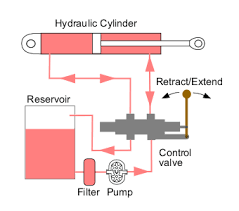Hydraulic systems are drive-systems in which movements are initiated and controlled using a fluid that is pressurised. The force that is generated can be used for lifting, bending, pushing, pressing, or cutting.

Applications
Hydraulic systems can be found in many settings, including buildings, vehicles, and processing plants. They are extremely important in a range of industries, including manufacturing, agriculture, construction, and robotics.
Pros of hydraulic systems
These systems can efficiently transmit significant amounts of power using relatively small amounts of fluid and a simple system of hoses and tubes. The amount of force can be adjusted as needed using force multiplication, and they can cope with a wide range of weights.
Hydraulic systems can be controlled using simple levers or push buttons and can be easily started, accelerated, or stopped as needed. They can deliver constant force/torque even when speeds change.
Hydraulic systems have fewer moving parts than electrical and mechanical systems. They do not cause sparks when in use, which means that they are safe to use in mines and chemical plants.
A growing market
Hydraulic Power Unit
A hydraulic power pack is an efficient and cost-effective way of providing power to hydraulic machinery. These packs are particularly useful for industrial work that is taking place outdoors.
If you feel that a hydraulic power pack could be the solution you are looking for, there are plenty of online resources that you can explore, such as the examples seen here hydraproducts.co.uk/Hydraulic-Power-Units/Standard-Power-Units.
Cons of hydraulic systems
Whilst they have many advantages, hydraulic systems do have some drawbacks.
The hydraulic fluids that are used in these systems are often messy and can also be dangerous because they are usually corrosive. This means that leakage can cause safety issues and environmental problems. It is also vital to ensure these fluids are free from contaminants, which requires constant filtration.

Hydraulic systems require intensive and regular maintenance and it can be tricky to find the precise parts if replacement components are needed.
A small leak in the pipeline can cause critical errors and increase the risk of accidents. In addition, hydraulic systems can sometimes deliver too much power and must be carefully regulated to ensure safety and component protection.
